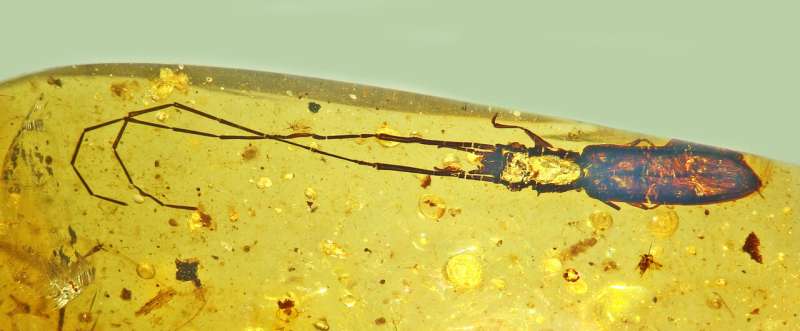This article has been reviewed according to Science X's editorial process and policies. Editors have highlighted the following attributes while ensuring the content's credibility:
fact-checked
trusted source
proofread
Scientists identify new species of beetle that used extra-long antennae to battle for mates, at the feet of dinosaurs

One hundred million years ago, as iguanodons and triceratops fled from hungry tyrannosaurs, another biological drama played out on the ground where the giant reptiles trod: Male beetles using their supersized antennae in combat for mates.
Researchers have identified a new species of beetle from Burmese amber, a specimen with antennae nearly 8 millimeters long attached to a 2.3-millimeter body.
George Poinar Jr., who holds a courtesy appointment in the Oregon State University College of Science, and collaborators named the new silvan flat bark beetle Protoliota paleus. Fernando Vega, a retired research entomologist with the U.S. Department of Agriculture, and Andrei Legalov of Russia's Institute of Systematics and Ecology of Animals collaborated on this study, which was published in Ecologica Montenegrina.
"This new insect differs from a previous member of the genus described in Burmese amber by its small body size, weakly protruding eyes, long mandibles and narrow pronotum," said Poinar, an international expert in using plant and animal life forms preserved in amber to learn about the biology and ecology of the distant past.
The pronotum is a prominent, plate-like structure covering all or part of the thorax of some insects; the thorax is the middle part of the body, where the legs and wings attach.
"We also see evidence of sexual secretions on tarsal hairs on the fossil beetle, similar to those that attract females on today's silvanid beetles," Poinar said. "So we have a scenario of a combative male beetle that chased females under the feet of dinosaurs. David Attenborough shows similar male beetles fighting over females in tropical forests today."
Although having such long antennae might have its drawbacks, like getting tangled in vegetation and otherwise hindering movement, those extended male antennae come in handy for finding mates as well as battling over them, Poinar said.
"Some modern beetles are known to walk along larval host trees with their antennae outstretched, looking for females that they recognize solely by antennal contact," he said. "Longer antennae mean a wider reach, increasing the likelihood of encountering a female. And of course the longer the antennae, the bigger the weapons the beetle has at its disposal for combat with other males."
There is no evidence, however, that female beetles choose mates by comparing antennae length.
"In our new specimen, the setal sex patches on its foretarsi probably produced pheromones that attracted females," he said. "And in addition to finding and fighting over females, the long antennae were likely used to shield the female during egg laying. This study is one of the rare times where behavioral patterns of a fossil insect can be surmised from its physical features."
Silvanidae, a beetle family in the superfamily Cucujoidea, consists of 62 described genera and about 500 described species, Poinar said. The family appears on all continents except Antarctica.
Most silvan beetles are saprophylic, meaning they live under the bark of dying or dead trees and eat fungi, the scientist said. Others such as the sawtoothed grain beetle and the merchant grain beetle are pests that feed on stored products.
More information: George Poinar Jr. et al, Protoliota paleus sp. nov. (Coleoptera: Silvanidae)—new long antennae beetle in mid-Cretaceous Burmese amber, Ecologica Montenegrina (2023). DOI: 10.37828/em.2023.62.9
Provided by Oregon State University





















